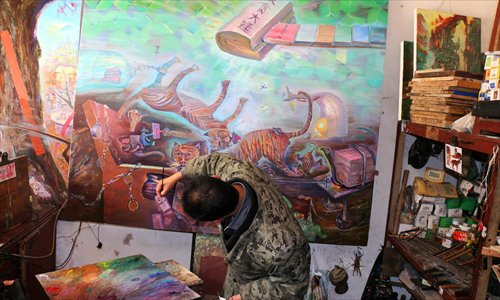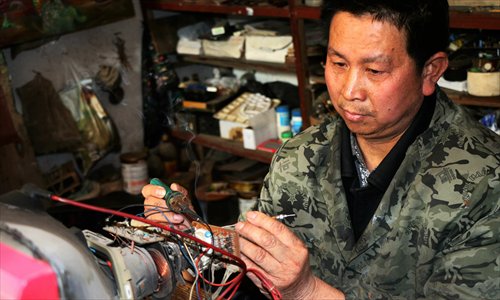Villager wins fame for portrayal of anti-corruption drive

Amateur artist Qu Wanrong works on a painting in his electric appliance repair shop. Photo: Courtesy of Liu Fei

Qu repairs a television in his shop. Photo: Courtesy of Liu Fei
An electrical appliance engineer in a village of Central China's Hubei Province recently won overnight fame after his latest anti-corruption painting was published by several leading Chinese media.
Qu Wanrong, 56, from Zhangjiakou village, Huanghua township, Yichang, is an amateur painter who dedicates his spare time to his pictures. He had been a carpenter for nine years before opening a household appliances repair shop in the village 27 years ago. In 2004, he started to teach himself to draw.
His village lies at the entrance to the Three Gorges Dam, the world's largest hydropower station. Although the traffic on the road in front of Qu's shop has become heavy since the project was completed in 2006, his business is on the decline.
These days, though, the number of people visiting his shop has suddenly increased, with neighbors, strangers, teachers and farmers, old and young, all come to see him. But they don't come to have their appliances fixed. Instead, they are eager to have a look at a 2-meter-wide and 1.5-meter-tall oil painting.
Hanging on the wall of the shop filled with a variety of electrical components, the picture shows tigers and flies under a giant hammer, depicting the central government's ongoing crackdown on both high- and low-ranking corrupt officials.
"Some drove down specially to see the picture. They feel happy that it expresses their support for the fight against corruption," Qu said. "I'm proud to represent ordinary farmers."
Eye on the news
Qu cares a great deal about State and world affairs. Since the new leadership took office in 2013, China has launched an unprecedented crackdown on corruption, which has toppled a number of high-profile officials. In February, on hearing that more corrupt officials fleeing overseas were being arrested and brought back, Qu felt that he had to do something with his paintbrush.
One night, he started to draw. "The anti-corruption campaign targeting both 'tigers' and low-level 'flies' launched by President Xi Jinping is inspiring. Ordinary people like me are very excited, and we should make it hard for corrupt officials to escape even if they have wings," Qu said.
The hammer in his painting is made up of several law books. On the biggest is written "Chinese Constitution." In addition to three tigers with human faces and a fat fly, Qu has also drawn several other animals to represent different types of corrupt officials, such as a tiny cow carrying a red seal, a snake circling a large bundle of money and an elephant coveting a bag of cash bribes which is being guarded by a tiger.
Passion for art
Born during the Great Leap Forward (1958-61), Qu didn't eat a solid meal before the age of 20. Due to his "middle-peasant" family background, he was not allowed to continue his studies after junior high school, even though he performed well academically, a fact which remains one of Qu's great regrets.
In 2004, a news story reignited his passion: an American had started to learn painting at the age of 72, and even managed to have his work collected by the Louvre Museum, Qu recalled. An idea immediately came to his mind. "If the American can do it, why can't I? I'm much younger than he is."
He started to learn drawing on his own. At the beginning, the decision met with opposition from his wife, as his daughter and son were both teenagers and he was the breadwinner of the family. They worried that the costs of painting equipment would increase the family's financial burdens.
But Qu didn't give up on the idea. When the day's business was over, the repair shop became his studio. At first, he practiced with pens on old newspapers and waste paper. Gradually, he transferred to Gouache, an opaque watercolor paint. To save money, he collected old wall calendars, rubbing the reverse sides of each page with sandpaper to turn them into canvas.
Chairman Mao, kids, young people, road construction workers, farmers, landscapes and cattle have all become the subjects of his paintings.
In 2010, Qu opened his first exhibition at his home. It attracted many spectators from his neighborhood, including some professional painters.
Gradually, Qu rose to fame in the neighborhood and some even approached him asking him to draw portraits for them. Others offered to buy his works out of admiration. In 2013, several expressway builders paid Qu 18,000 yuan for 80 oil paintings.
One day in 2013, Qu boarded a bus carrying a painting of intellectuals who were forced to wear tall paper hats during the Cultural Revolution (1966-76), a way to humiliate "rightists." Seeing the painting, an old man on the bus insisted on buying it, saying he had been forced to wear the same hat at that time, something his grandchildren found unimaginable.
Moved by the old man's sincerity, Qu agreed to sell the picture. The old man took 2,000 yuan from his pocket and gave it to Qu.
Not for fame
So far, Qu said he has made over 100,000 yuan from his paintings. But of the 1,000 or so works he has completed in the past decade, most have not been put up for sale.
"I do not draw for fame, nor for profit," Qu said. "Drawing can make me forget all my troubles."
"I want the painting to be displayed in a public museum. It should end up being shown to caution officials and the coming generation."
Liu Fei, a publicity official from Huanghua township, was the first person who introduced Qu's anti-graft painting to the outside world. In March, he took some pictures of the painting and published them online. The painting immediately went viral on the Internet.
"The limelight has put pressure on local officials, but we definitely support Qu's anti-graft drawings," Liu said, noting that the government is preparing to organize an exhibition for Qu.
Qu said his anti-graft works will continue, and that he already knows the subject of his upcoming works: America and Australia sending corrupt fugitives back to China, and villagers with steel bars in hand chasing corrupt officials to the edge of a cliff.
Newspaper headline: Painting out graft